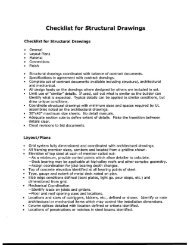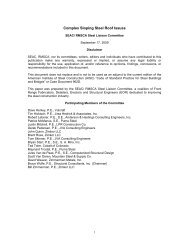Architecturally Exposed Structural Steel - Arquitectura en acero
Architecturally Exposed Structural Steel - Arquitectura en acero
Architecturally Exposed Structural Steel - Arquitectura en acero
You also want an ePaper? Increase the reach of your titles
YUMPU automatically turns print PDFs into web optimized ePapers that Google loves.
Exterior <strong>en</strong>vironm<strong>en</strong>t, low-<strong>en</strong>d primer/finish coating: acrylic (waterbased)<br />
finish coat with a shop coat primer over an SSPC-6 surface<br />
preparation.<br />
levels, the finish will be bright and shiny. Many steel makers<br />
control the overall impurity cont<strong>en</strong>t but not these two specific<br />
elem<strong>en</strong>ts, so there might be some parts that are bright and shiny<br />
and some that are dull gray. Care should be tak<strong>en</strong> wh<strong>en</strong> specifying<br />
a particular steel for hot-dip galvanizing if an architectural<br />
finish is expected.<br />
A. Hot-Dip Galvanized Finish: Apply zinc coating by<br />
the hot-dip process to AESS indicated for galvanizing<br />
according to ASTM A 123. Fabricate such that<br />
all connections of assemblies are made in the field<br />
with bolted connections. Provide galvanized finish<br />
or members and assemblies within the range of<br />
color and surface textures pres<strong>en</strong>ted in the mock<br />
ups.<br />
PART 3 — EXECUTION<br />
3.1 EXAMINATION<br />
A. The erector shall check all AESS members upon delivery<br />
for twist, kinks, gouges or other imperfections<br />
which might result in rejection of the<br />
appearance of the member. Coordinate remedial<br />
action with fabricator prior to erecting steel.<br />
3.2 PREPARATON<br />
A. Provide connections for temporary shoring, bracing<br />
and supports only where noted on the approved<br />
shop drawings. Temporary connections not<br />
shown shall be made at locations not exposed to<br />
12 AESS Supplem<strong>en</strong>t Modern <strong>Steel</strong> Constrution May 2003<br />
Exterior <strong>en</strong>vironm<strong>en</strong>t, high-<strong>en</strong>d primer/finish coating: polyurethane<br />
finish coat with an epoxy intermediate coat and zinc rich primer over<br />
an SSPC-6 surface preparation.<br />
view in the final structure or as approved by the<br />
Architect. Handle, lift and align pieces using<br />
padded slings and/or other protection required to<br />
maintain the appearance of the AESS through the<br />
process of erection.<br />
3.3 ERECTION<br />
A. Set AESS accurately in locations and to elevations<br />
indicated, and according to AISC specifications refer<strong>en</strong>ced<br />
in this Section.<br />
B. In addition to the special care used to handle and<br />
erect AESS, employ the following erection techniques:<br />
Editor’s Note: The following is a list of special erection issues<br />
that can impact the final appearance of the AESS. Many of<br />
these items have significant cost premiums and should not be<br />
used indiscriminately. Refer to the cost matrix for anticipated<br />
range of added cost associated with each line item.<br />
Editor’s Note: The AISC Code of Standard Practice specifies<br />
that AESS framing shall be constructed to one-half the tolerance<br />
of typical structural steel frames. This requirem<strong>en</strong>t is int<strong>en</strong>ded<br />
to improve fit up wh<strong>en</strong> the exposed steel interfaces with<br />
other materials such as curtain wall masonry, etc. If this is not<br />
the case, standard tolerances are more economical. The variations<br />
permitted under the standard frame tolerances noted in<br />
Chapter 7 will typically be acceptable wh<strong>en</strong> viewed by eye<br />
(without instrum<strong>en</strong>ts).







